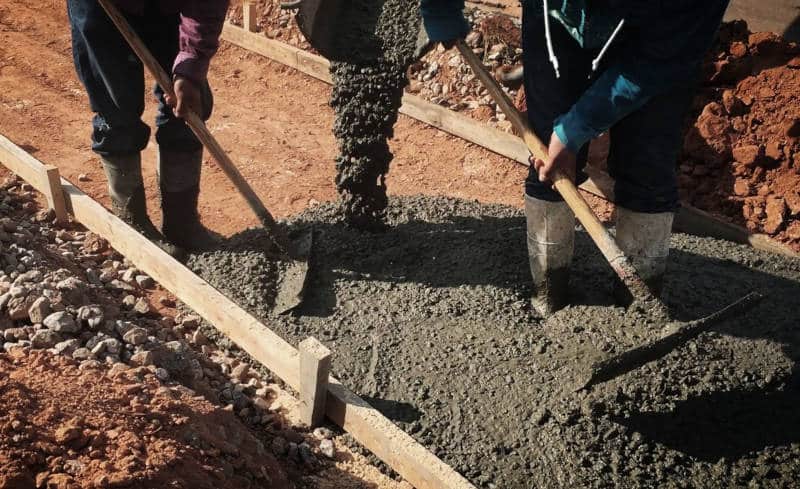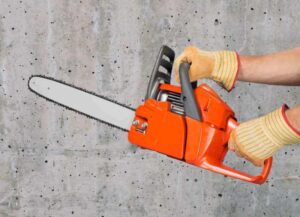Site preparation is the most important aspect of a successful concrete project. Without proper preparation, the likelihood of cracks forming in the completed slab is increased. So, how do you prepare the ground for concrete?
The key to properly preparing ground for concrete is to have a well-compacted subbase. Start with cleared ground, digging out the spot for the slab. Add the subbase and compact with a vibrating plate compactor. Add gravel and tamp until smooth. Then the ground is ready for the concrete to be added.
Preparing ground for concrete can be mostly straightforward, but you want to make sure you cover all the steps to have a good finish.
How do you prepare ground for concreting?
Preparing the ground for concreting involves levelling the ground, adding a subbase and gravel, tamping and compacting for a smooth surface to pour concrete on. The first thing to do is clear the area you want to concrete by removing old concrete, debris, stones, shrubs, and grass. Once you have cleared the area, dig the ground to the right depth and size for your concrete slab. Typically the depth should be between 5 and 7 inches. You can use a string and line technique as a level to make sure the ground isn’t sloped.
Have a base layer of either native or improved soil between 4 and 6 inches. If you live in colder areas, or you’re building a concrete driveway, you should increase the base layer thickness to between 10 and 12 inches.
Smooth out the base layer using the flat side of a rake. Fill in low spots with some more of your base material. It’s important to get the ground as level as possible using the soil at the very beginning. Once it’s level, compact this base using a vibrating plate compactor. It helps to slightly dampen the base for better compaction.
Then tamper the base layer using a hand or mechanical tamper. Once you have tampered your base layer, walk on the soil. If barely any footprints are left, your soil is well compacted. Then you can add at least 2 inches of gravel for your next layer. Compact this layer with a tamper until it is flat and smooth.
Once everything has been tightly compacted, levelled, and smoothed out, your ground has been properly prepared for concrete. You might want to consider putting plastic under a concrete slab before pouring the concrete too.
Can you pour concrete directly on dirt?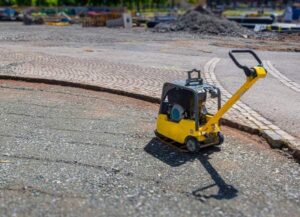
You can pour concrete directly onto dirt, but it won’t be as durable and last as long as concrete poured onto properly prepared ground. The weight of the concrete can mess up the dirt base over time. This leads to flawed and cracked concrete slabs. To keep your concrete crack-free and stable for as long as possible, you should properly prepare the ground first.
Make sure to level and compact the base properly using a plate compactor. Since a good base makes all the difference, it will prevent potential cracks. Also, add a layer of gravel after you have compacted the base well. It will provide additional load support and drainage needs.
What do you put down before laying concrete?
Before laying concrete, you need to put down a solid subbase. A subbase refers to any material that the concrete will rest on. Soil alone can be used as a subbase if it’s compacted and stable enough. But, in most cases, some granular fill will usually be added.
Before adding the subbase, you have to compact the soil underneath which is referred to as the subgrade. Once the subgrade is compacted, you can lay a gravel subbase that is between 4 and 8 inches. To properly prepare a subbase before laying concrete, use a tamper to compact the gravel until it’s smooth. Check out our B300 forward plate compactor for great compact results! You can then also put down a protective layer of plastic under the concrete.
Do I need gravel under a small concrete slab?
Putting gravel under a small concrete slab is good for additional support of the finished slab. Gravel can provide a solid base layer for a concrete slab of any size. It’s also great to help with moisture drainage that will prolong the lifespan of your concrete slab. If you have a small concrete slab, putting gravel under it will help prevent cracks from forming and the slab from becoming a safety hazard.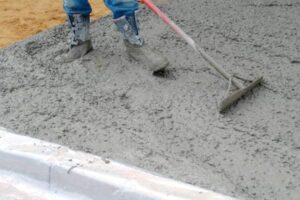
Without the drainage offered by gravel under concrete, water can pool in the concrete, leading to erosion. This causes the concrete to crack and sink. So, for safety and a solid finish, even small concrete slabs should have gravel under them.
You don’t have to have gravel if you don’t want to. But we highly recommend putting gravel under concrete. There are many more advantages than if you were to leave this step out to speed up the process.
Should you wet the ground before pouring concrete?
You should not wet the ground before pouring concrete on it. Saturated or just very wet ground has the potential to affect the strength of the concrete after it’s been poured. A slightly damp ground is okay because by properly preparing the ground, the moisture will be able to seep out. This won’t cause damage to the concrete. But lots of water on the ground is bad for concrete pouring.
Standing water puts the quality of concrete at risk. Since concrete develops its strength through curing, too much water will weaken it. Try to remove as much water as possible from the ground before pouring the concrete. You can lay plastic on the ground as a protective layer between moisture and concrete if you’re pouring concrete during a wet season.
In summer, it’s easy to let the ground dry out before pouring concrete. But sometimes you can’t wait for summer, so you need to properly prepare the ground for concrete. This includes reducing the moisture and pouring concrete on as dry land as possible.
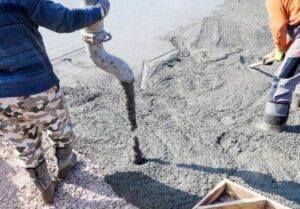 Can you pour concrete over grass?
Can you pour concrete over grass?
Concrete shouldn’t be poured over grass. You have to properly prepare the ground before pouring concrete. Pouring concrete over grass will cause cracks from moisture ingress, lack of rigidity, and lack of support as the grass beneath can deteriorate over time.
Grass will infiltrate the layers of the concrete, leaving plenty of room for moisture to pool inside it. This damages the concrete. The soils underneath the grass will also not be properly compacted, resulting in the concrete cracking even more and sinking. This leads to many safety hazards from one concrete slab. So, take the time to properly prepare the ground for concrete and don’t just pour it over grass.
While you’re working with and thinking about concrete, do you know if you can use an angle grinder to level concrete? Do you know how to use a concrete core drill? We have a helpful guide to concrete core drills to help you out! For quality cutting and grinding tools, check out Paragon Tools Australia!

